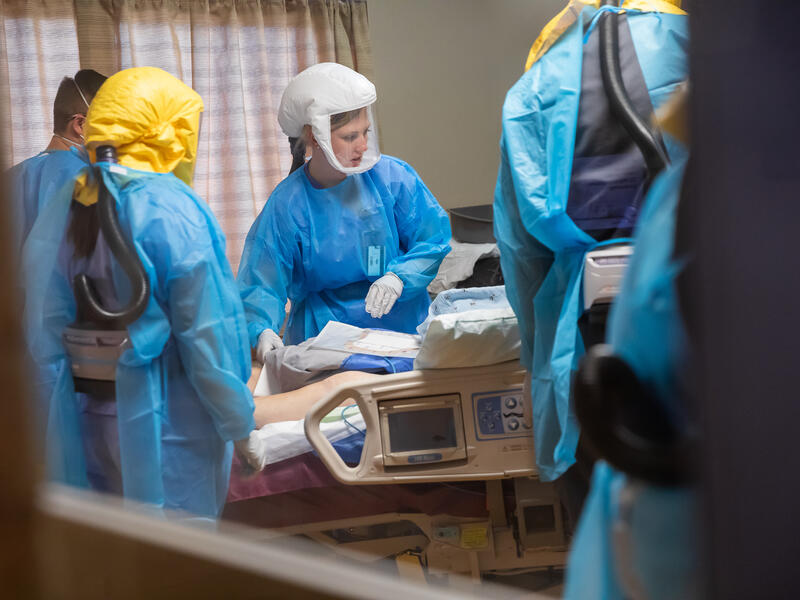March 2020 marked the start of an unprecedented year.
Here are the stories from the front lines of the COVID-19 pandemic, one year later.
Waiting games
Avish Nagpal, M.D. is an infectious disease specialist for Sanford Health in Fargo, North Dakota. He said as the novel coronavirus slowly spread across the world, so did fear. Very little was known about the virus that’s now claimed the lives of nearly 2.6 million people globally.
“At that time, we didn’t even know the virus could be transmitted asymptomatically,” he said.
From the very beginning of the pandemic, inpatient clinical care leader Melanie Allen volunteered to be a caregiver on the COVID-19 unit in Fargo. She said a heavy and uncertain feeling encapsulated everyone on her wing.
“I saw a lot of fear in people’s eyes,” she said.
Part of the fear, she said, stemmed from the waiting games both providers and patients had to play in the early days of the pandemic.
“I was pretty terrified. My first patient was actually negative, so it took us a few days, about three or four, before we actually had a positive. But that’s when the testing took three or four days,” she said.
Supporting patients, families
The coasts were the first to see the pandemic in the U.S.
When the virus reached the middle part of the country, it quickly became a situation where events were changing by the minute.
Daniel Field, M.D., an internal medicine physician at Sanford Health in Bismarck, North Dakota, says he is proud of the way his co-workers rallied to take care of those who needed help, especially at the height of the pandemic.
“All those people who, not even day by day, but hour by hour, and minute by minute took care of patients. You can’t put into words what they went through. Patients were dying in front of them,” he said.
For Sanford Bemidji respiratory care and sleep center manager Amie Maddox, the defining moment of the pandemic’s severity came when she had to say goodbye to a patient turned friend.
“That was probably my hardest point. I remember seeing family of his sitting outside his glass door just watching him and not being able to be with him. I know you’re not supposed to have a favorite, but he was one of those.
“That was my lowest point,” she said.
Dan Hanson, a critical care nurse in Bemidji, Minnesota, says like Maddox, he’ll never forget the heartbreak he felt as he watched families “not be able to grieve the way they wanted to.”
He recounts an instance when a family member had to say goodbye to her mother through glass windows, and couldn’t in-person.
“She was screaming, yelling, and just bawling. Eventually, one of the other staff members who had also lost a family member to COVID was able to comfort her by just sitting with her and letting her cry.
“To not be with those people when you decide to withdraw care, and to not have that same experience in the dying process, that was something I’ll never forget,” he said.
Rallying together
Despite tough days during the fall surge, Sanford Health as an organization “really pulled together,” said Marcia Kummer, clinical manager of the critical care unit in Sioux Falls, South Dakota.
“People from all over the hospital came in to help us, knowing our staff was tired. They were stressed. They’ve worked extra hours just to make sure the patients were taken care of. It really showed what a team we have and that our ICU team could really pull together and take care of very critical patients.”
Through long hours and long days, Kummer and her team persevered to meet the needs of patients. She said Sanford Health helped them to do that.
“Sanford really put an effort forward to make sure that we had everything we needed to take care of these patients. Bringing us extra staff, bringing the nurses food so when they couldn’t get away from the floor, or floors, they at least had enough food and beverage to sustain them through the day,” Kummer said.
A shot of hope
As the end of 2020 drew near, hope came. Allen said the vaccine brought palpable excitement and relief.
“We might be able to get past this,” she said.
Kummer said she felt the same way.
“The vaccine has given us a hope for the future,” she said. “Maybe someday we can have a unit with no COVID patients in it. Not seeing the devastation of what the disease and the illness has done to others. It can hit a young person just as hard as it hits the 80-year-old.”
In less than a year, three COVID-19 vaccines were rolled out. A truly miraculous feat, if you ask Dr. Nagpal.
“The vaccine is rolling out. We are talking about immunizing every adult in the United States who wants to get a vaccine. They can probably get a vaccine by this summer,” he said.
“It feels like a really long time this last one year. But we have never made such tremendous progress on any disease in the history of medicine. Miracles are possible when all of us work together.”
Learn more
- ‘Psychological PPE’ resources offered for front-line workers
- COVID-19 patient: ‘There’s no place like home’
- COVID long-hauler still recovering one year after diagnosis
…
Posted In Bemidji, Bismarck, COVID-19, Fargo, Nursing and Nursing Support, Physicians and APPs, Sanford Stories, Sioux Falls

